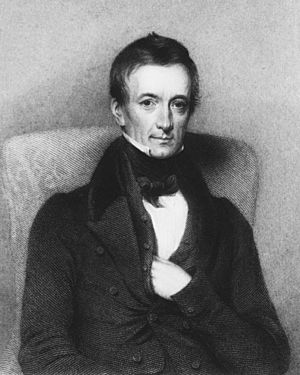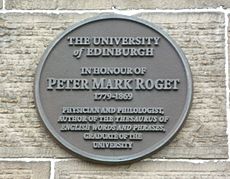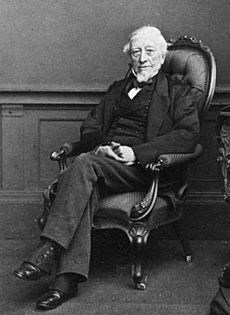Peter Mark Roget facts for kids
Quick facts for kids
Peter Mark Roget
|
|
|---|---|

Official portrait by Thomas Pettigrew
|
|
| Born | 18 January 1779 |
| Died | 12 September 1869 (aged 90) West Malvern, England
|
| Alma mater | University of Edinburgh |
| Known for | Thesaurus of English Words and Phrases |
| Spouse(s) | Mary Taylor Hobson (1824–1833) |
| Children | 2 |
Peter Mark Roget (born 18 January 1779 – died 12 September 1869) was a British doctor and writer. He is most famous for creating Roget's Thesaurus of English Words and Phrases. This book, first published in 1852, is a collection of words grouped by their meaning. It helps people find the perfect word for what they want to say. Roget also studied how our eyes see things. He wrote about an interesting optical illusion in 1824. This work helped explain how we see movement in movies and cartoons.
Contents
Early Life and Education

Peter Mark Roget was born in London, England. His father was a pastor from Geneva, and his mother was Catherine Romilly. When his father passed away in 1783, his family moved to Edinburgh, Scotland.
Roget later studied medicine at the University of Edinburgh. He finished his studies and graduated in 1798. His uncle, Samuel Romilly, helped him with his education. His uncle also introduced him to important social groups of the time.
After university, Roget attended more medical classes in London. He lived in Clifton, Bristol, for a short time. There, he met other important scientists like Humphry Davy.
In 1802, Roget became a tutor for two young boys. He traveled with them on a long trip around Europe. This trip was called a "Grand Tour." They were held as prisoners in Geneva when a peace treaty ended suddenly. Roget managed to bring his students back to England in 1803.
Roget's Medical Career
Roget became a private doctor for a nobleman named William Petty. After this, he worked at the Manchester Infirmary. He also started teaching about how the human body works.
In 1808, he moved to London. He became a licensed doctor with the Royal College of Physicians. Roget worked at several hospitals and gave many lectures. He taught at places like the Russell Institution and the Royal Institution. In 1817, he joined the staff at the Queen Charlotte Hospital.
Roget also helped investigate diseases at a prison called Millbank Penitentiary in 1823. In 1828, he helped write a report about London's water supply. In 1834, he became the first professor of physiology at the Royal Institution. He also helped start the University of London in 1837. Roget stopped working as a doctor in 1840.
Creating the Thesaurus
After retiring from medicine in 1840, Roget began working on his famous book. This book is what most people remember him for today. Some people believe Roget struggled with sadness throughout his life. It is thought that creating the thesaurus helped him cope with these feelings.
He started keeping a notebook of words grouped by their meaning in 1805. This was the beginning of his great work. He also became the first secretary of the Portico Library in Manchester.
The first version of his word collection was printed in 1852. Its full title was Thesaurus of English Words and Phrases Classified and Arranged so as to Facilitate the Expression of Ideas and Assist in Literary Composition. The book was very popular. It was printed 28 times during Roget's lifetime. After he passed away, his son and grandson continued to update and expand the thesaurus.
Other Interests and Discoveries
Roget was chosen as a member of the Fellow of the Royal Society in 1815. This was because of his work on a special type of slide rule. He also served as a secretary for the Royal Society for many years.
On 9 December 1824, Roget shared a paper about a strange optical illusion. This paper was published in 1825. It described how the spokes of a spinning wheel seem to bend when seen through small openings. This idea was important for understanding how our eyes see motion. It helped explain how animation and movies work. Roget also said he invented a device called the "Phenakisticope" in 1831. This was one of the first devices to show moving images.
Roget helped start the Medical and Chirurgical Society of London. This group later became the Royal Society of Medicine. He also helped create the Society for the Diffusion of Useful Knowledge. For this group, he wrote many helpful guides. He wrote several papers about health and how the body works. He also wrote articles for the Encyclopædia Britannica.
Roget was also a chess player. He wrote an article that solved a famous chess puzzle called the "knight's tour." He also created his own chess puzzles. He even designed a small, easy-to-carry chessboard.
Personal Life
In 1824, Roget married Mary Taylor. They had a son named John Lewis and a daughter named Kate.
Later in his life, Roget became deaf. His daughter, Kate, took care of him. He passed away in West Malvern, England, when he was 90 years old. He is buried in the churchyard of St James' Church there.
Roget in Books and Plays
Peter Mark Roget has appeared in several creative works.
- A Canadian writer named Keath Fraser wrote a story called Roget's Thesaurus in 1982. In this story, Roget himself tells the tale.
- Roget is also a character in a play by Shelagh Stephenson called An Experiment with an Air Pump. The play is set in 1799, and Roget is an assistant to one of the main characters.
- A picture book about Roget's life was published in 2014. It is called The Right Word: Roget and His Thesaurus. This book won awards for its illustrations and for being an excellent children's non-fiction book.
Images for kids
See also
 In Spanish: Peter Mark Roget para niños
In Spanish: Peter Mark Roget para niños
- Roget's Thesaurus
- Optical illusion
- Persistence of vision



